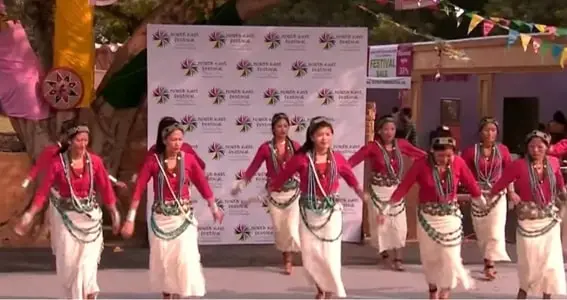The people of Arunachal Pradesh are celebrated for their vibrant festivities and energetic dance displays. Every festival unites the state’s tribes in a seamless blend of traditional clothing, jewelry, music, and dance. These captivating folk dances enhance the festive vibe and recount tales of bravery, preserving oral traditions passed through generations. Moreover, these dances serve as a cultural gateway, offering outsiders a peek into their heritage. With fervent celebrations, their traditional folk dances stand as captivating spectacles, showcasing the richness and beauty of their cultural traditions.
Bhuiya dance

The Bhuiya dance is a joyous celebration performed by Digaru Mishmi women and men. It typically follows grand feasts, family gatherings, and festivals such as Tazampu, Duiya, and Tanuya. This dance plays a significant role in fostering and strengthening bonds among people within the community.
Chalo dance
The Chalo dance holds great importance within the Chalo Loku festival, a traditional celebration observed by the Nocte tribe in Arunachal Pradesh annually during October and November. This festival serves as a farewell to the past season and marks the anticipation of the forthcoming paddy cultivation season. The Chalo dance is an integral part of these festivities, symbolizing this transition and welcoming the new agricultural cycle.
Wancho dance
The Wancho dance holds significant importance within the Oriah festival, a traditional celebration observed by the Wancho tribe during the spring months of March and April. This dance plays a crucial role in uniting tribe members, fostering solidarity and togetherness during this festive occasion.
Pasi Kongki
Pasi Kongki, a well-known folk dance of the Adi tribe, uniquely represents their vibrant culture. This dance is a tribute to the courageous Pasi individuals who bravely ventured to obtain essential items for their village, depicting their bravery through dance and song.
Ponung dance
The Ponung dance holds immense religious significance for the Adi tribe and is performed by a circle of dancing girls and ladies. This ceremonial dance serves as a prayer to God before the harvest season, accompanied by a male Miri who sings a folk song and plays the Yoksha instrument.
During the performance, the song narrates stories about the Adis’ history, the origins of their crops, and various other aspects of their heritage. In addition to playing the Yoksha, the Miri also uses other instruments, one of which has a sword-like shape. The Miri shakes this instrument while singing, adding a unique rhythmic element to the Ponung dance.
Popir dance
The Popir dance, a renowned performance by the Galo tribe of Arunachal Pradesh, holds significant cultural importance. The tribe celebrates numerous festivals annually, and this dance might be a tribute to the goddess Mopin Ape, revered as the deity of abundance and fertility among the Galo people. Mopin Ape is one of the most cherished goddesses within the Galo tribe’s beliefs and traditions.
Bardo Chham dance
The term “Bardo Chham” translates to “Dance of the Zodiacs.” In the Sherdukpens community’s beliefs, twelve evils exist, each associated with a month of the year, akin to the twelve zodiac signs. These evils take on various animal forms throughout the year. The Sherdukpens convey this belief during local festivities through the Bardo Chham dance.
Chham dance
Both male and female members of the Sherdukpens community actively participate in the Bardo Chham dance, considering it a deeply cherished tradition. This dance serves as a symbolic representation of the victory of good over evil. By portraying these evils, it emphasizes humanity’s ongoing battle against these adversities, highlighting the triumph of goodness prevailing over malevolence.
Santosh Kumar is a Professional SEO and Blogger, With the help of this blog he is trying to share top 10 lists, facts, entertainment news from India and all around the world.
